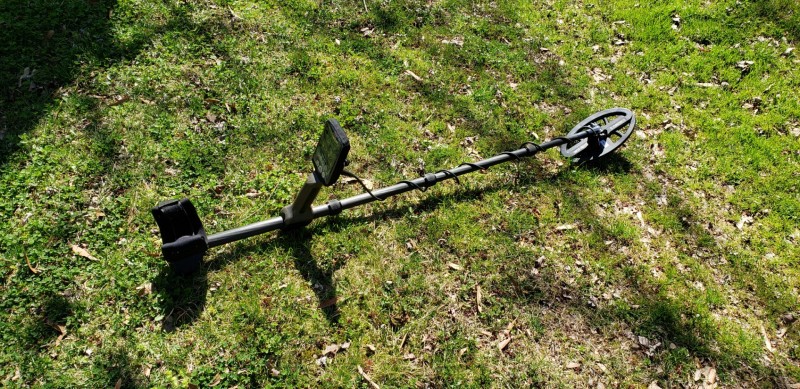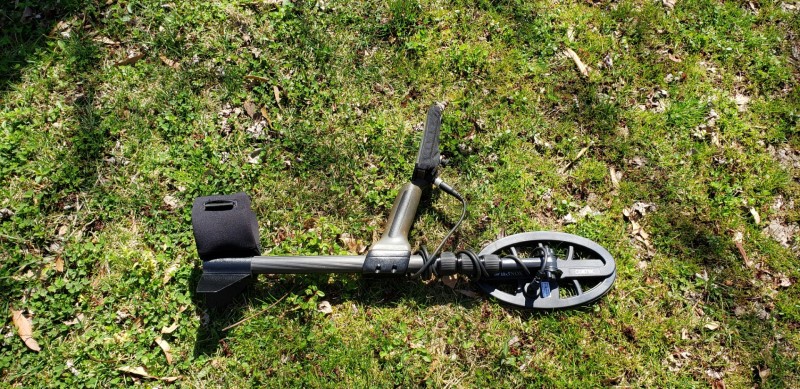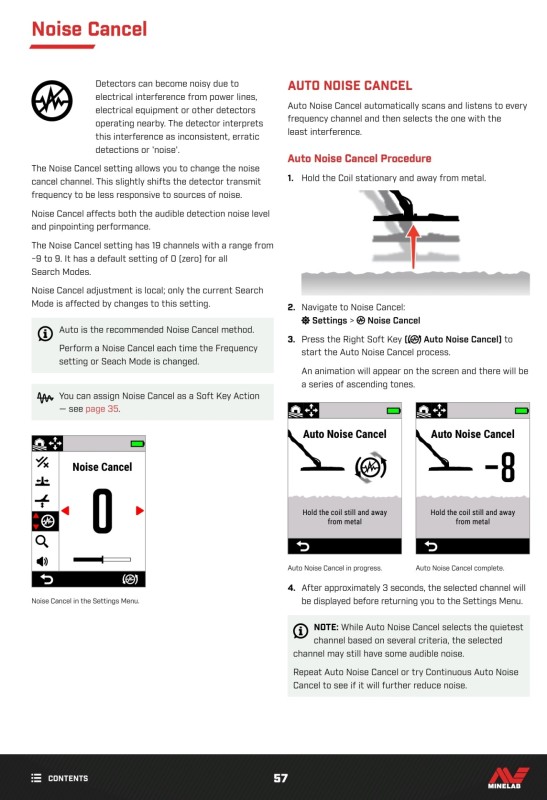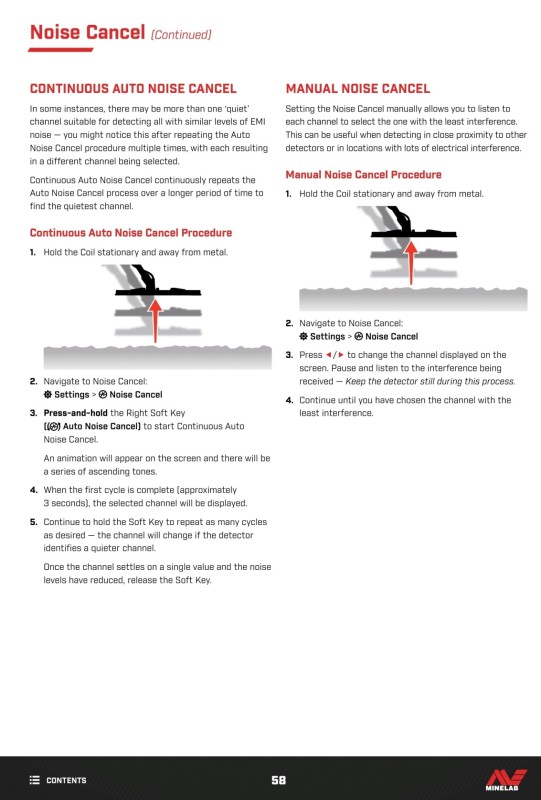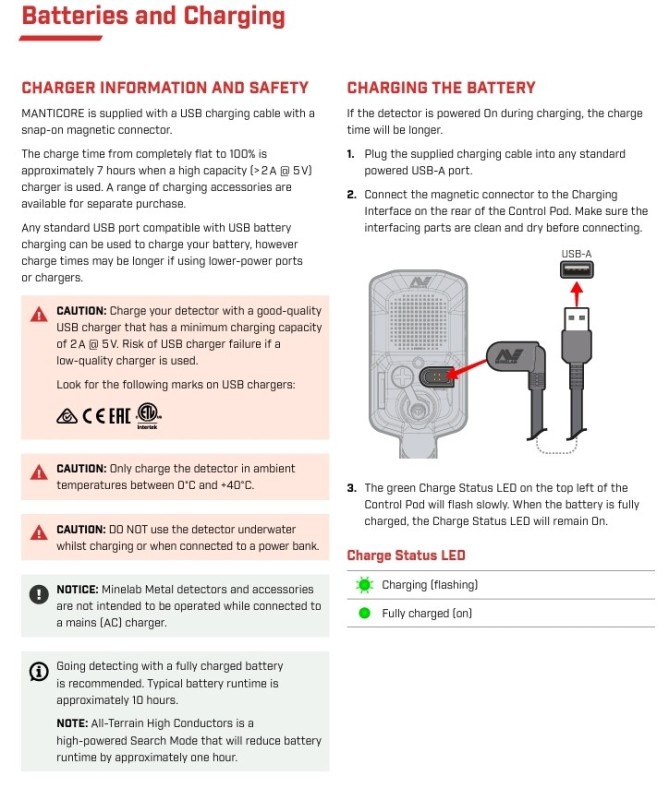-
Posts
6,119 -
Joined
-
Last visited
Content Type
Forums
Detector Prospector Home
Detector Database
Downloads
Everything posted by Chase Goldman
-
Let us know what type of soil you are generally dealing with (mild or hot/mineralized?) - that can help make us make more useful recommendations because frankly I have used Relic, General, Sensitive, and Deep HC as base programs for relic hunting in different soils and situations. Relic is deep and works for just about every soil situation I've encountered. I set IAR from 3 to 5 to enable ferrous tones to be differentiated from non-ferrous PCM Pitch tones and an audible threshold setting I also notch out 00 because of a high pitch tone bug (you will still "hear" it as the threshold will blank) which is usually mineralized ground feedback or tiny ferrous oxides in the soil. I set sensitivity as high as I can and go with a Reactivity of 1 in open field searching. I lower sensitivity into the mid-80's and run reactivity at 2.5 or higher in machine gun iron. I use General as an alternative to Relic in moist fields. Deep HC as an alternative to Relic for deep, high conductive targets and hot dirt, and Sensitive as a change of pace mode or for searching for high conductors in thick iron. For the General, Sensitive, and Deep HC base programs I set disc from 7 to 10, use PCM Pitch tones, set Iron Volume to 3, Audio Response to 4 or 5. I don't use notches on these programs unless I am just going for nickels/high conductors in heavy trash in which case I notch everything up 57, leave a window from 58 to 66, and then notch up to 83 or so. I set up my custom programs adjacent to one another typically straddling Relic so that I can quickly switch between them to interrogate targets. As with relic I adjust sensitivity as high as I can for open field searching and set reactivity as low as I can for the conditions at hand (0 to 1 for open fields, low target densities; 2 to 3 for high target densities). And if I am in machine gun iron, I will lower sensitivity to the mid-80's to lower iron overload/masking and "sift" for non-ferrous masked targets utilizing a high reactivity setting. HTH
-

Are 900 Shafts Available And Compatible For My 800?
Chase Goldman replied to ChuckScrivener's topic in Minelab Equinox Forum
I bought a telescopic shaft a few years back that no longer appears to be available. I found a similar one on eBay here: https://www.ebay.com/itm/374136170390?chn=ps&var=643043211599&norover=1&mkevt=1&mkrid=711-117182-37290-0&mkcid=2&mkscid=101&itemid=643043211599_374136170390&targetid=1263433206214&device=c&mktype=&googleloc=9008150&poi=&campaignid=14859008593&mkgroupid=130497710760&rlsatarget=pla-1263433206214&abcId=9300678&merchantid=6296724&gclid=CjwKCAiA_vKeBhAdEiwAFb_nrcZ9OZGLsyYIhXMcZ0i0igDUu8DoccxRmaU42m-Jv2VJUurCH-P0kBoCM4cQAvD_BwE Here's my compact Nox 800 setup with a similar shaft: -
Lot's of good analysis in your post regarding the comparison of the VDI scales and sensitivity ranges, but just wanted to clarify that ML states that transmit power is reduced not gain/sensitivity in Beach 2 or when the Nox goes into Beach black sand overload mode. So I'm not sure mode plays into the sensitivity variation equation when comparing Nox and Manticore. FWIW.
-
Depends on the type of target, but it is not unusual because just about everything but gold corrodes in that environment. A conductive corrosion induced "halo" can form around the target while it sits in the situ can depress target ID until the target is disturbed and the corrosion halo is broken. Multiple adjacent targets, especially targets of widely different conductivities in the same hole can also exhibit this behavior. This is not unusual behavior for many detectors, but I don't have enough experience with the Legend at the beach to make a judgment as to whether it is better or worse than other detectors.
-
Not sure why you had to negotiate with them, but it probably had to do with the fact that all battery replacements are probably covered by the warranty for the next two years, so they haven't really thought about it from a customer cost standpoint. Probably the main sticking point is that if it has to be factory replaced, then the question of who pays for shipping of the entire detector back to the factory comes to into play. In any event, not something you'll probably have to worry about for several years down the line. If it fails out of the gate (or within the first 2 years), you are covered by the warranty. Considering the cost of the detector, I would imagine anything less than $100 would be considered reasonable (that's 2.5% the MAP of the detector) and I'm sure it's probably half of that. Glad you eventually got a reasonable answer.
-

Manticore And Emi (and The Magic Word -- Depth)
Chase Goldman replied to GB_Amateur's topic in Minelab Manticore Forum
Yep. So that definitely optimizes the quietest channel. But I am trying to reconcile Steve G's point (based on Tom's statements) that it also somehow obviates the need to do Tom's "silent" EMI air test - which implies more than just finding the quietest channel. I will follow up with Tom since he now has my question. Frankly though, I believe I am splitting hairs. I personally have not ever fretted about silent EMI, but the statement is out there by Tom so I'm simply curious. And if the Manticore is really just finding the quietest channel by repeated scans and nothing more, that in itself a decent incremental improvement over Nox. -

Manticore And Emi (and The Magic Word -- Depth)
Chase Goldman replied to GB_Amateur's topic in Minelab Manticore Forum
And I wonder just how it manages to do that. In other words, what is the feedback mechanism that accomplishes that. Looking at Tom D's "contnuous "manual noise cancel" algorithm. He manually gets air test depth data from every channel to determine which one is optimal. I could see Long Press doing that if it had a target to calibrate from. But that is not what is happening, from what I can tell. I wonder if he has done side-by-side comparisons of his manual method and "Long Press". From the Manticore User's Guide. (Note that "Long Press" noise cancel is officiall called "Continuous Auto Noise Cancel"): -

Manticore And Emi (and The Magic Word -- Depth)
Chase Goldman replied to GB_Amateur's topic in Minelab Manticore Forum
I have asked Tom for more insight as to what is really going on with long press noise cancel. Is it just re-scanning what it thinks are the most quiet channels (after a "short press" scan) or is there some additional EMI mitigation going on. I think it's the former and your experience tends to back this up. If it's the latter, the question is "what is the downside then?" - because as Steve H always says, "There is no free lunch". -

Manticore And Emi (and The Magic Word -- Depth)
Chase Goldman replied to GB_Amateur's topic in Minelab Manticore Forum
When I asked Tom D about Depth vs. EMI on Manticore and his "nominal" 23% depth improvement vs. Equinox, this was basically what he was talking about Raw Depth is impacted by: [Detector: Sensitivity + EMI Mitigation (coil power) + Recovery/Separation (processing speed) + Signal Processing(target identification/rejection)] + [Environment: Target Characteristics (conductivity, mass, orientation) + Soil Conditions + EMI present] = Effective Depth. There are so many variables and interdependencies (e.g., you can increase sensitivity if EMI is less severe), there is no pat answer. Tom appears to be saying - in aggregate Manticore provides about 23% more depth than the Nox on average for the range of conditions and targets Tom D encounters. What is interesting is the "range" of performance improvement for Tom D's situations is 67% more depth to 2% more depth, depending on the combination of the above. -
Yeah. Wasn't trying to shoot the messenger, Andy. I know where you were coming from. Just commenting on Tom's info that he presents as "fact" because he throws around these numbers like they're verified data. Sounds like there is growing consensus regarding M-core's above average beach performance capabilities especially compared to the Nox. If that was Minelab's focus and they were leaning heavily on feedback from that demographic, like Tom, then mission accomplished. We'll see if it came at the expense of (or wihout benefit to) other capabilities and modes, such as prospecting.
-

Not Another Deus 2 Comparison Video!
Chase Goldman replied to CPT_GhostLight's topic in XP Deus II Forum
Bingo. With Pitch PCM, audio nuances and subtle distortions are introduced (vs. the cleaner square audio) that can help give telltale clues on things like jagged aluminum canslaw and large pieces of aluminum prior to digging them. I won't say you can rely on it to NOT dig this junk, but it certainly sets your expectations and mindset that you are likely digging junk, such that if it turns out wrong, then you are pleasantly surprised. Another weird side effect of PCM vs. Square audio is that it also changes how your MI-6 wireless pinpointer sounds. I find the "PCM" pinpointer audio to be more dynamic and gives you a better sense of the proximity of the target to your pinpointer to make it more effective at zeroing-in on your target. But it can annoy people like audible itching powder so it's an "acquired taste" and not everyone's cup of tea. That's why it's good XP provides the option of either audio setup. -
NP - glad you got the thread going so we could point Legend folks in the right direction on APTX-LL compatible 3rd party gear. This info had been embedded in the Minelab forum sections because until Nokta intoduced Legend. ML was the only major detector manufacturer to utilize BT APTX-LL for wireless audio.
-
"[A]pprox 23% deeper"- Would love to know how he arrived at that number. By putting an "approximate" but specific number down that tends to sway people that he is espousing fact, yet no objective evidence or background is provided to verify that number. Simply interested in the basis for the "23% deeper" claim? Controlled testing data? Real world "nominal-median-average" target recovery depth data? Ratios of max sensitivity settings? Something else? And yes...even if there is a solid basis for the depth comparison claims, they only apply to the mild sandy soils - not mineralized hot dirt sites.
-
Same here, and I'm an engineer! He writes like he is taking technical shothand notes for himself (probably a habit based on his background). Sometimes this style results in gaps and loss of context that the reader has to infer or fill in. As a result, his comments can occasionally be ambiguous or misinterpreted. And assumptions on his part (because ML is not going to divulge all the proprietary details to an outside tester/contributor) are taken as gospel fact by readers. Like any high profile detectorist, he's very knowledgeable about his primary detecting niche (S. FL beaches and mild soil inland sites) but has less experience outside of that. So it's impossible for him to give useful feedback outside his wheelhouse. That's why ML is getting input from contributors across the globe, not just Tom D. We all have a wheelhouse where we primarily excel (prospecting, salt beach surf, dry sand, hot dirt relics, park coin shooting, etc.) based on the sites we have the most access too and the types of targets we enjoy recovering most. True even for those of us who dabble in multiple different detecting pursuits. My point is only that Tom D. has experience gaps in his detecting resume (as we all do), so tempering his M-core comments by understanding his limited frame of reference and seeking multiple opinions on M-core from multiple sources with diverse detecting experiences is essential for determining the actual strengths and weaknesses of Manticore (despite its versatility) and making an informed buy decision. This forum is one of the best sources for obtaining those diverse points of view on any particular detector. I have had to restrain my early adopter impulses on this one and that's not easy. BUT am glad I did. Not because I think M-core is falling short or is not a great detector (no doubt it is a great detector - at certain tasks), but because I am gaining a better understanding of whether it brings anything to the table that I don't already have with my current detector lineup (D2/Nox 900/GPX, Tarsacci and Legend). Instead, I hopped on the Nox 900 bandwagon because I understood better its plusses and minuses (mostly plusses so far) over the 800. M-core may be in my future, but frankly I haven't found the thing that compels me to spend that much coin for it. I thought the deep high conductor capability was going to be the thing, but Simon's feedback has tempered my enthusiasm on that and D2 is no slouch. The D2 does all I need it to do at the Beach and even bottlecaps are a thing if the past, so I don't see a need to grab one for that task. So it really just comes down to curiosity regarding how I might be able to utilize the 2D screen and Ferrous Limits for relic hunting in mild and hot dirt. It's going to have to jump high to beat the depth, TID stability, and EMI immunity of the D2 on beach and land, Nox and Legend have me covered on the diverse backup SMF detector and 10x5 coil front, Tarsacci on raw VLF depth in mild and hot dirt, and the GPX is the king of depth in the hot dirt relic fields of Virginia. Not sure where M-core and it's $1.6K price tag fits at the moment.
-

Added A Power Bank To My Manticore
Chase Goldman replied to BigSkyGuy's topic in Minelab Manticore Forum
True. The issue is when current is running through the magnetic connector pins. Agreed, but it is amazing how uncommon, common sense is. The cold charging thing is not so obvious, and wanted people to know about it. -
Hey great original post here but just wanted to clear up some of the terminology regarding bluetooth because it does confuse just about everyone. If don't you want to wade through all the Bluetooth background and jargon, you can just skip down to the TL;DR Bottom Line paragraph at the end of the post. Need to recognize the difference between the Bluetooth spec revision (i.e., 4.x, 5.x, etc.) and the codecs used because they are two different things. The Bluetooth spec revision determines what codecs and bluetooth control features (track selection, fast forward, etc.) can be supported but does not guarantee what the equipment manufacturer chooses to support. Bluetooth supports a number of different codecs (SBC, AAC, APTX, APTX-HD, APTX-LL, APTX Adaptive, LDAC, LC3). Each of these codecs behave differently and have different advantages and disadvantages regarding noise immunity, audio fidelity, latency, maximum transmission distances, etc. Some of these codecs (e.g., SBC) are basic and universal and provided for all BT variants. Others (such as APTX) are proprietary but compliant with version 4.x and 5.x BT hardware and software but the equipment provider has to pay a licensing fee to implement the proprietary codec (that's why you have to specifically look at the hardware specs to see if the APTX codec is supported). And others such as LC3 are only compatible with the latest variant of BT (BT 5.3). Also, as you can see, there are multiple variants of APTX but only APTX-LL and APTX Adaptive have the minimal latencies that work well for metal detecting. Legend and the Nox 600/800, and GPX 6000 are compatible with headphones that support only the basic (but non-low-latency) SBC codec but only support APTX-LL for low latency. Bottom line, to emphasize what DSMITH was saying, if you want low latency and want the threshold feature to work properly with your wireless phones, then the phones need to specifically say they support APTX-LL. It's not good enough to just say low latency, because there are codecs that have less latency than SBC but are still not as good as APTX-LL for minimal latency. So just because you got BT headphones that say they are BT 5.3 compliant (the latest BT spec), if they don't also support APTX-LL then they will not support the low latency when used with your Legend, Nox, etc. So do I. They're great and I have not been able to find anything else that does everything these do (loudspeaker with stereo, high fidelity sound space, retractable earbuds that can be used in lieu of the loudspeakers, and also utilizing the APTX LL codec. Note that the bad news is that APTX-LL is now an obsolete codec and is being phased out by Qualcomm which licenses the codec. What this practically means is that the number of headphones and earbuds out there that support the APTX-LL will steadily decline in the coming years. Qualcomm has moved on to APTX Adaptive, but that is not supported by the Legend and Nox 600/800, and GPX 6000 detectors. BT 5.3 now supports the BT Low Energy (BT LE) LC3 codec as a more universal low latency codec and it has latencies that are even better than APTX-LL. It appears that the new NOX 700/900 and Manticore support BT LE, but whether they utilize the LC3 codec is unclear as there are no third party headsets out there yet that support LC3 to test with the Manticore/Nox 700/900. Do a search on DP Forums for threads that discuss APTX-LL compatible hardware for the Nox 600/800 and GPX 6000 and that hardware if it still exists, will also work with the Legend in "LL" mode. Here is one such thread: TL;DR Bottom Line: If you want a 3rd party set of wireless blutooth headphones, earbuds, or speakers that are 100% compatible with your Legend (or Nox 600/800 or Vanquish) and that have minimal delay, make sure they explictly support the APTX-LL codec. If they just say "low latency" in the description that does not guarantee they will work in APTX-LL low latency mode with these detectors. It has to specifically say it supports APTX-LL in the specs.
-
This is interesting because up to this point what I've heard is that the M-core handles EMI better than the Nox. Long press noise cancel and all that (I have some thoughts/Questions on M-core long press noise cancel and whether it is really doing anything really magic vs. just scanning the subset of "quietest" channels and picking one of those - based on my read of the user manual but will save that deep dive for a separate thread). Basically. what I'm hearing here is that sensitivity (at least for micro gold) has to be boosted on M-core into the red line region to get the same sensitivity as the Nox. In other words, it just appears more immune to EMI because it's sensitivity scale has been expanded (more resolution) rather than actually being increased over the Nox 900 - i.e., the "scales" are using different numbers (so there is not a one-to-one correspondence from a numbers standpoint) but the sensitivity range and high end are roughly equivalent. The better EMI handling of the M-core is primarily a sort of illusion as a result of "25" (just to pick a number) on the M-core being more quiet than 25 on the Nox, but that "25" on the M-core is more like (25/35) * 28 (Nox 900 full sensitivity setting) = 20 on the 900 and the 800 (assuming a one to one scale correspondence between the 0 to 25 Nox 800 and 900 scales with the Nox having 3 additional units of sensitivity). I agree with the statement below. Would need more data across a range of different conductors. We'll see you there, Andy. 😉 I feel the same about the 900 TID stability, so far, but need more real world swing time on it.
-

Added A Power Bank To My Manticore
Chase Goldman replied to BigSkyGuy's topic in Minelab Manticore Forum
Understood. Just wanted to make sure people considered all the implications of doing this if they were inclined to rig this up. Like I said in my original reply, it was a nice setup. -

Added A Power Bank To My Manticore
Chase Goldman replied to BigSkyGuy's topic in Minelab Manticore Forum
Will not void the warranty as long as you re-assemble it correctly. But if you mess up the O-ring during the changeout and get water intrusion, then that probably won't be covered. I always have a charging bank and the right cables in my backpack (if I'm more than a couple hundred yards from the vehicle) as an emergency backup for my cell phone, wireless audio gear, go pro, and detector. It also has a built-in flash light. -

Added A Power Bank To My Manticore
Chase Goldman replied to BigSkyGuy's topic in Minelab Manticore Forum
That's also an option, though it's one thing to do the changeout on your workbench vs. dealing with the screws etc. in the field and it's always a risk that you damage, get dirt on or mis-seat the o-rings while doing the changeout. Also, the plastic mounts and brass fasteners have limited stress cycles as well, so this is not something you want to be doing on a routine basis. Then you have to figure out how to re-charge the replaced battery external to the detector (or break down the detector yet again to charge it back up using the detector charger). Would like to see what people are actually getting in terms of real world run times once these M-core batteries are broken-in and optimized. I think 10+ hours of run time per full charge will be the norm and this will hopefully end up being a non-issue as it was for the Nox. -

Added A Power Bank To My Manticore
Chase Goldman replied to BigSkyGuy's topic in Minelab Manticore Forum
It's less about the added weight (15+% more in this case> 0.5 lbs added to a 2.9 lb. detector) than the other considerations. But on long detecting days, every oz counts in my book. Not saying it shouldn't be done, just putting the other considerations (water, temp) out there for info because they often get overlooked. It definitely makes sense to have as an emergency backup option or trekking to a remote location. -

Added A Power Bank To My Manticore
Chase Goldman replied to BigSkyGuy's topic in Minelab Manticore Forum
I know this is going to come across as a Debbie Downer post, but after having owned a Nox for 5 years, I’ve never been in a situation where a fully charged Nox couldn’t get through an entire day’s worth of detecting without having to juice it up (I’m talking 8 to 10 hours of detector “power on” run time - my body battery dies before I do). So though I have pondered it, I’ve never seen the need to deal with the minor drawbacks associated with home brewing such an external battery mod, as much as I like the thought that went into this particular one. I have had issues, however, with wireless headphone and external wireless transmitter batteries making it through the day. Some of the drawbacks to consider if going the power bank route: obviously having to deal with the added weight (which will be worse if you consider the fact that the main reason for doing this is that you want to keep swinging the detector for as long as possible, no matter how balanced you make it, it's still more weight on your arm), the fact that it means the detector certainly can’t then be used in water and probably can’t be used in the rain with the charging cable attached (even if the external battery pack is protected, you can’t fully protect the magnetic connector and charging bank connector from moisture intrusion while sourcing current with the ML proprietary cable), and, finally, taking care not to be charging the detector battery at or below 32F/0C air temp which would risk permanent damage the built-in battery (Li cells can be operated in temps below freezing, but cannot be be charged if they are at or below freezing without causing damage that permanently reduces battery capacity due to the chemical process that occur during charging), though since the ground is likely frozen in those conditions you likely won’t be detecting in those conditions. Definitely make sure you don’t leave the detector in your vehicle or in a non-heated space while charging with air temps below freezing. Note the cautions regarding charging with moisture present and at low temps on page 13 of the user manual: I recognize the M-core is a different beast with higher power requirements and a lower advertised run time vs. the Nox, so an external bank might be a necessary evil now, but hopefully not. As an alternative, consider a refreshing charge when breaking for lunch or whatever, or switching to a comparable back-up detector to give the M-core a chance to recharge. -

Epic Hunt That Almost Wasn't
Chase Goldman replied to Chase Goldman's topic in Metal Detecting For Coins & Relics
Thanks. It’s actually the first Large Cent for me that wasn’t toasted to the point I couldn’t get the date off it. I figure that since we found it in the “garden” of the original structure it wasn’t subject to the corrosion inducing tumbling and chemicals of the worked fields. -

Epic Hunt That Almost Wasn't
Chase Goldman replied to Chase Goldman's topic in Metal Detecting For Coins & Relics
Thanks. Had to do some post hunt research. Bob and I were scratching our heads on it when it came out of the ground. -

Sharing A New Permission
Chase Goldman replied to F350Platinum's topic in Metal Detecting For Coins & Relics
Amazing day. Thanks Bob! See more about this hunt here...- 17 replies
-
- coin found
- relic found
-
(and 1 more)
Tagged with:


